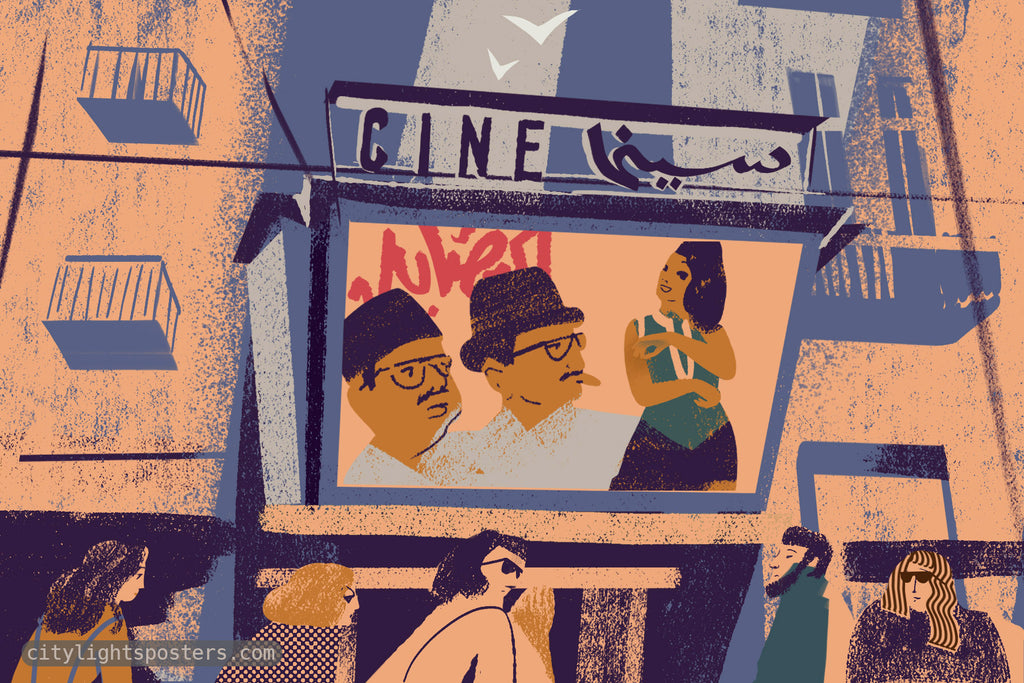Syrian Cinema: Reflecting the Joys and Sorrows of the Arab World

By Juan Mella
When we think of what Syrians produced for the screen, we might immediately think of dramas. We’d remember the times we sat glued to the television, waiting for yet another episode from one of our favorite shows. We’d remember looking forward to their funny scenes, interesting dialogues, and lighthearted characters who carried a sense of purity that seemed out of this world.
However, long before Syrian dramas became a part of our homes, we had come to know and love Syrian productions through the silver screen. Taking off from comedy as a starting point, Syrian films expanded into different genres, tackling social and political issues, and gaining a reputation locally, regionally, and even internationally The history of Syrian cinema celebrates a number of popular works that we are always happy to revisit, dwell on and reminisce over.
DURAID LAHHAM AND NIHAD QALEI: THE SYRIAN LAUREL AND HARDY
The early 1920’s saw the rise of Laurel and Hardy, the iconic comedy duo of the silent film era, who succeeded in making audiences laugh without saying a word. Decades later, Syrian cinema invented its own version of this duo, starring Duraid Lahham and Nihad Qalei; unlike their western counterparts, these two were never silent, they’d go on and on, sparking joy and laughter.
 |
Duraid and Nihad first met on a late-night show, when Syria and Egypt were under the United Arab Republic. It was then that their popular screen characters emerged, with Duraid as “Ghawwar Al-Tosheh” and Nihad as “Husni Al-Borazan”. They went on to play these roles in most of their cinematic appearances.
Syrian cinema mainly started with comedy films, which were an important means of entertainment for most people at a time when owning a TV set was a luxury that only few households could afford. That said, the silver screen was an ideal place to hang out with friends and family, and the films of Duraid and Nihad completely fit that purpose, especially since they were considered appropriate by the local standard; even their romantic scenes were delivered in a light, comic, and, most importantly, decent manner.
 |
It all started with The Pearl Necklace in 1964, starring Duraid and Nihad, and featuring the Lebanese singer Sabah, in addition to the Syrian singer Fahd Ballan. The Pearl Necklace was a major hit, and it paved the way for many great gems to come, where the iconic duo was accompanied by a number of other stars from Syria, Egypt, Lebanon, and Turkey. The career of Duraid and Nihad was filled with great works, including the 1965 feature Meeting in Palmyra, which is a romcom set in the ancient city of Palmyra and its well-known ruins, and Love in Istanbul (1966), which is set in Turkey.
Just like Duraid and Nihad traveled the world with their talent, they also invited talent into Syria. Shadia hailed from Egypt to sing in their 1969 film The Ladies Tailor, where she performed “Ya Teirah Teeri Ya Hamamah” (i.e., Fly Away Little Pigeon), while surrounded by the breathtaking landscape at the historic Hijaz railway. Sabah came back for another appearance with the duo in The Millionairess (1966), in which she performed a number of songs that became very popular. Even the Egyptian icons Farid Shawqi and Nabila Ebeid have had their share of on-screen mischief with Duraid and Nihad in The Three Swindlers (1968), in which a gang goes after Ghawwar’s wealth and stirs up conflict.
Perhaps the most famous Ghawwar-and-Husni film is the 1975 Sah El-Nom, which gave life and color to the black and white series with the same title. This film introduced unforgettable characters, including Abu Antar: the tough guy character played Naji Jabr, as well as Fattoum Heis Beis: the woman at the heart of romantic competition between Husni and Ghawwar, and whose role was played by Najah Hafiz. There’s also the remarkably sweet Yassin Baqoush as “Yassin”, and Abdullatif Fathi as “Badri Beik Abu Kalabshah”. Among all other works by Ghawwar and Husni, Sah El-Nom is known to hold a very special place in people’s hearts, and the final scene will forever be engraved in collective memory, with Ghawwar singing “Fattoumeh” behind prison bars.
 |
Duraid and Nihad’s endless stories are part and parcel of the history of Syrian cinema, which generally sparked heartfelt laughter, and delivered clever messages to those who could read between the lines, without using any sophisticated symbolism. Indeed, Duraid and Nihad’s popularity stems from their ability to appreciate and entertain their audiences.
ON-SCREEN TEMPTATIONS
When speaking of Syrian cinema, one can’t help but remember Nihad Alaeddin, known professionally as “Ighraa”. This multi-talented woman certainly left her mark, whether as a producer, writer, or actress. As the liberation movements spread in Syria throughout the 70’s and 80’s, Ighraa’s films became bestsellers, attracting audiences to the big screen with some erotic scenes.
While Ighraa’s films were mostly commercial, they also delivered some key ideas. For example, I’d Die Twice and Love You (1976) tackles the subordination of women, and it critiques outworn traditions related to the consummation of marriage on the wedding night. In this film Ighraa acts alongside Naji Jabr to portray a harmonious marriage, where the wife is dedicated to supporting her working-class husband.
 |
Another signficant film is the 1972 feature The Leopard, which is based on a postcolonial novel by Haidar Haidar about a farmer who struggles against feudalism. This critically-acclaimed film won many awards locally and internationally, but after all these years, what audiences remember most vividly is Ighraa’s nude scene in the middle of the woods. Ighraa also had a role alongside Osama El-Romani in The Adventure (1974), an adaptation of Saadallah Wannous’ play Ras Almamluk Jaber, which is loaded with controversial political ideas.
In addition to writing, producing, and acting, Ighraa also directed some films, including the 1981 Karate Girls, in which she played the main character. However, she was more successful as an actress and producer than as a director.
Another important film in Ighraa’s career is Naked Without Sin, where she and her sister Fitna portray the suffering of women in a patriarchal society which forces them to go down a road that they would not otherwise choose for themselves. Also addressing feminist issues was the 1986 An Eastern Girl, starring Ighraa and Ghada Al-Shamaa. This film undermined gender stereotypes which deemed beautiful women an easy target for men.
Ighraa’s contribution to Syrian cinema goes beyond her ability to attract audiences with explicit content. The scenes she performed were most definitely considered daring, and temptatious, to say the least, but her films also told stories that were very relevant to Syrian society in the 70’s and 80’s. Her films shone a light on many feminist issues, albeit by capitalizing on female sexuality as a main attraction.
SOCIAL AND POLITICAL ISSUES IN SYRIAN CINEMA
Most of the films we have brought up thus far are undeniably commercial comedies; they were entertaining, sometimes even thrilling. The morals they aimed to convey, if any, were straightforward and simple. However, these films represent a segment of Syrian production which is concerned with igniting joy and laughter. Yet Syrian cinema in its entirety also encompasses a plethora of works that address social and political issues on local and regional levels.
Duraid Lahham often stepped out of Ghawwar’s shoes to play other roles in films that highly resonated with the bitter political reality of the Arab world. For instance, his 1984 film The Borders shows the tragic experience of loss and fragmentation, and it criticizes the borders separating Arab countries. In The Report (1986), Duraid teamed up once more with Raghda and played the character of Azmi Beik, an employee who loses his job after refusing to sign a deal that implies embezzlement, filing a report to higher authorities about the ordeal.
 |
In addition to frowning upon modern malpractices, Lahham also presented a case for abandoning unpleasant traditions: his film Kafroun (1990) argued for replacing revenge with good education and loving manners. In this film, Duraid plays the character of Wadud, who works as a guard at a primary school, therefore coloring the film with a hint of childhood innocence. Lahham later made an entire kids’ movie called Little Parents (2006), co-starring Egyptian actress Hanan El-Turk.
Besides Duraid Lahham, many other filmmakers used cinema as a medium for delivering ideas of social and national importance. Lost in Disloyal Eyes (1989), starring Adeeb Qaddoura, Samar Sami, and Najah Hafiz, highlights the home-wrecking consequences of a man cheating on his wife. Summer Rain (1984) shows the tragic ending of Nadia’s love story, the protagonist whose father decides to marry her off for money, in an arrangement that looks more like a business deal. Jackal Nights (1988) by Abdellatif Abdelhamid discusses the life of a fragmented rural family, highlighting the personal turmoils of its members.
The Palestinian cause also had its share of Syrian film and television. The Survivor (1995), which is an adaptation of Ghassan Kanafani’s novel Returning to Haifa, tells the story of a Palestinian child who is stolen from his real parents and raised by Zionist settlers, which serves as a metaphor for the arbitrary nature of Israeli occupation of Palestinian land.
 |
Over more than three decades, Syrians crafted unique narratives for the screen. Although war-torn today, Syrian cinema will always be home to the laughs of Ghawwar, Husni and Abu Antar, colored by the beauty of Ighraa, Fitna, Raghda, Sabah, and Samia El-Jazaeri, while at the same time representing larger causes and themes that are relevant across the Arab world.
Visit the City Lights Posters’ Syrian Posters Collection to view some of the hardest-to-find Syrian film posters.
Juan Mella is a Syrian journalist, art critic, and producer. He has been working in media journalism since 2016. Mella is the Editorial Director of ET Syria and a Program Producer for Al-Alam Syria TV. He regularly contributes to Raseef22, Fan w Nas, and Nos Khabar platforms. He is also the Deputy Director of Public Relations at Mashhad Institution for art and performance training.
Subscribe to our newsletter to receive the latest latest blog updates, poster releases, and special offers.
